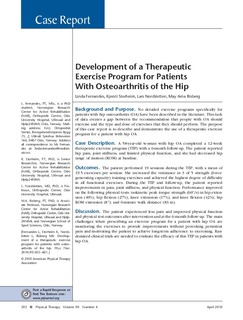| dc.contributor.author | Fernandes, Linda | |
| dc.contributor.author | Storheim, Kjersti | |
| dc.contributor.author | Nordsletten, Lars | |
| dc.contributor.author | Risberg, May Arna | |
| dc.date.accessioned | 2010-08-23T12:21:35Z | |
| dc.date.available | 2010-08-23T12:21:35Z | |
| dc.date.issued | 2010-02-25 | |
| dc.identifier | Seksjon for idrettsmedisinske fag / Department of Sports Medicine | |
| dc.identifier.citation | Physical Therapy. 2010, 90(4), 592-601 | en_US |
| dc.identifier.issn | 0031-9023 | |
| dc.identifier.uri | http://hdl.handle.net/11250/170639 | |
| dc.description | Copyright 2010 APTA. http://dx.doi.org/10.2522/ptj.20090083 | |
| dc.description.abstract | BACKGROUND AND PURPOSE: No detailed exercise programs specifically for patients with hip osteoarthritis (OA) have been described in the literature. This lack of data creates a gap between the recommendation that people with OA should exercise and the type and dose of exercises that they should perform. The purpose of this case report is to describe and demonstrate the use of a therapeutic exercise program for a patient with hip OA.
CASE DESCRIPTION: A 58-year-old woman with hip OA completed a 12-week therapeutic exercise program (TEP) with a 6-month follow-up. The patient reported hip pain, joint stiffness, and limited physical function, and she had decreased hip range of motion (ROM) at baseline.
OUTCOMES: The patient performed 19 sessions during the TEP, with a mean of 19.5 exercises per session. She increased the resistance in 3 of 5 strength (force-generating capacity) training exercises and achieved the highest degree of difficulty in all functional exercises. During the TEP and follow-up, the patient reported improvements in pain, joint stiffness, and physical function. Performance improved on the following physical tests: isokinetic peak torque strength (60 degrees /s) in hip extension (40%), hip flexion (27%), knee extension (17%), and knee flexion (42%); hip ROM extension (8 degrees ); and 6-minute walk distance (83 m).
DISCUSSION: The patient experienced less pain and improved physical function and physical test outcomes after intervention and at the 6-month follow-up. The main challenges when prescribing an exercise program for a patient with hip OA are monitoring the exercises to provide improvements without provoking persistent pain and motivating the patient to achieve long-term adherence to exercising. Randomized clinical trials are needed to evaluate the efficacy of this TEP in patients with hip OA. | en_US |
| dc.language.iso | eng | en_US |
| dc.publisher | American Physical Therapy Association (APTA) | en_US |
| dc.subject | exercise therapy methods | en_US |
| dc.subject | hip joint | en_US |
| dc.subject | movement | en_US |
| dc.subject | muscle strength | en_US |
| dc.subject | osteoarthritis | en_US |
| dc.subject | rehabilitation | en_US |
| dc.subject | pain measurement | en_US |
| dc.subject | range of motion | en_US |
| dc.subject | walking | en_US |
| dc.title | Development of a therapeutic exercise program for patients with osteoarthritis of the hip | en_US |
| dc.type | Journal article | en_US |
| dc.type | Peer reviewed | en_US |
| dc.subject.nsi | VDP::Medical disciplines: 700::Clinical medical disciplines: 750 | en_US |
| dc.subject.nsi | VDP::Medical disciplines: 700::Health sciences: 800 | en_US |
| dc.source.pagenumber | 592-601 | en_US |
